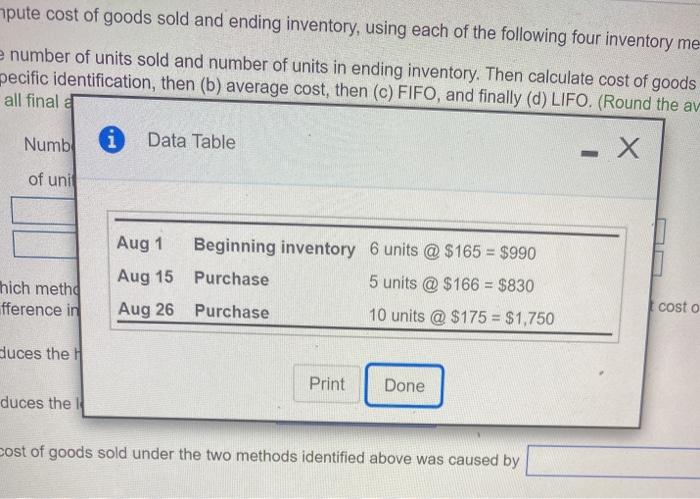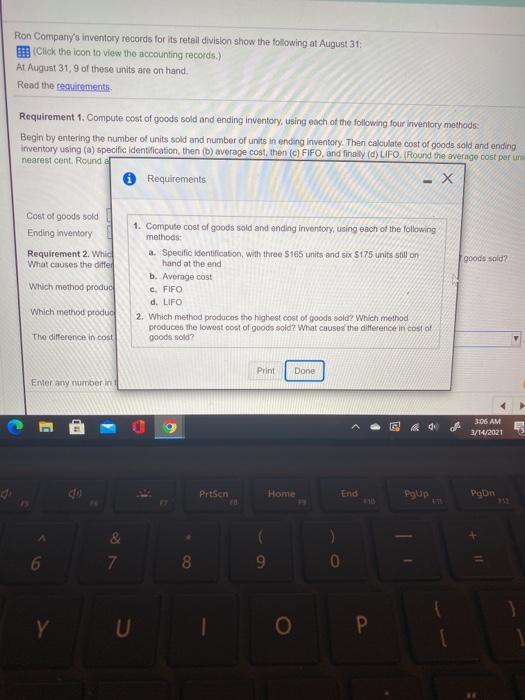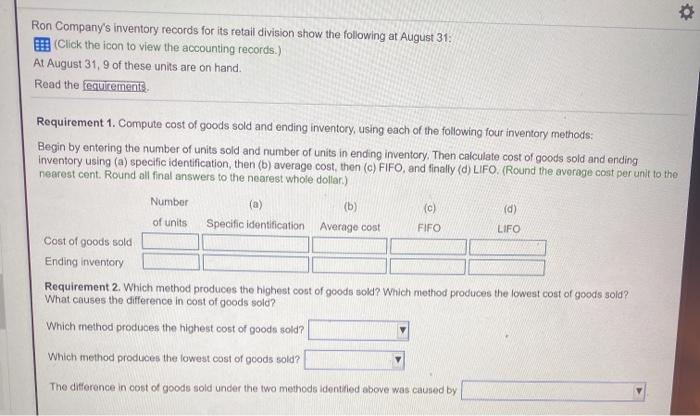pute cost of goods sold and ending inventory, using each of the following four inventory me e number of units sold and number of units in ending inventory. Then calculate cost of goods pecific identification, then (b) average cost, then (C) FIFO, and finally (d) LIFO. (Round the av all final Numbe i Data Table - of unit hich metho ifference in Aug 1 Beginning inventory 6 units @ $165 = $990 Aug 15 Purchase 5 units @ $166 = $830 Aug 26 Purchase 10 units @ $175 = $1,750 costo duces the Print Done duces the cost of goods sold under the two methods identified above was caused by Ron Company's inventory records for its retail division show the following at August 31: Click the icon to view the accounting records.) At August 31,9 of these units are on hand Read the requirements Requirement 1. Compute cost of goods sold and ending inventory, using each of the following four inventory methods Begin by entering the number of units sold and number of units in ending inventory. Then calculate cost of goods sold and ending Inventory using (a) specific identification, then (b) average cost, then (C) FIFO and finally (d) LIFO (Round the average cost per un nearest cent. Round Requirements X Cost of goods sold Ending Inventory Requirement 2. Whid What causes the diffel 1. Compute cost of goods sold and ending inventory, using each of the following methods: a. Specific identification, with three $165 units and six $175 units still on hand at the end b. Average cost goods sold? Which method produc c. FIFO Which method produs d. LIFO 2. Which method produces the highest cost of goods sold? Which method produces the lowest cost of goods sold? What causes the difference in cost of goods sold? The difference in cost Print Done Enter any number in 306 AM 3/14/2021 Prisen Home End Poup POD 6 7 8 9 Ron Company's inventory records for its retail division show the following at August 31: Click the icon to view the accounting records.) At August 31, 9 of these units are on hand. Read the fequirements of units Requirement 1. Compute cost of goods sold and ending inventory, using each of the following four inventory methods: Begin by entering the number of units sold and number of units in ending inventory, Then calculate cost of goods sold and ending Inventory using (a) specific identification, then (b) average cost, then (c) FIFO, and finally (d) LIFO. (Round the average cost per unit to the nearest cent. Round all final answers to the nearest whole dollar) Number (a) (b) (c) (d) Specific identification Average cost FIFO LIFO Cost of goods sold Ending inventory Requirement 2. Which method produces the highest cost of goods sold? Which method produces the lowest cost of goods sold? What causes the difference in cost of goods sold? Which method produces the highest cost of goods sold? Which method produces the lowest cost of goods sold? The difference in cost of goods sold under the two methods identified above was caused by









